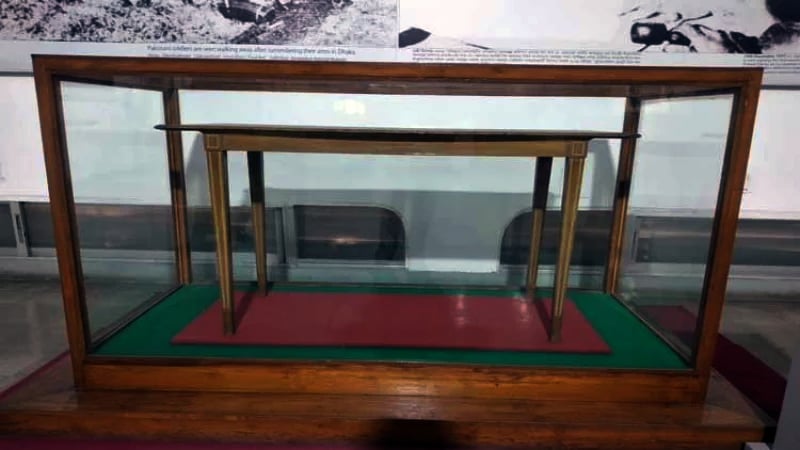
By Anisur Rahman
DHAKA, Dec 14, 2022 (BSS) – The National Museum in the capital kept on display prominently an ordinary wooden table – which, actually, is an extra-ordinary relic that stimulates the nation’s memory lane reminding the historic moment when Dhaka became the free capital of a free country.
The desk is the wooden surface on which Pakistan inked the unconditional surrender document conceding its complete defeat marking the final victory of Bengali nation in a ceremony.
The event is said to be the world's first such military capitulation in public on an open ground under open sky.
Pakistan's last military commander in their so-called eastern theatre Lieutenant General AAK Niazi signed the surrender instrument in the late afternoon of December 16, 1971, to the allied forces' commander Jagjit Singh Aurora at Dhaka's the then Racecourse and now called Suhrawardy Udyan.
The event was held on the plain ground while the ceremony required just a table and two chairs.
But it remained largely unknown how the arrangement was made in haste and who was entrusted with that task to do it until 2012 when an Indian war veteran, Brigadier General Sant Singh, told BSS reporter Anisur Rahman that he was the man, who arranged the historic ceremony.
Singh revealed the interesting piece of information, though it was not an issue of great concern for him or anybody else against the backdrop of a historical episode as he was talking to this reporter on the sidelines of a ceremony in Dhaka.
The old general, whom the freedom fighters in 1971 fondly called "Brigadier Babaji" because of his affectionate attitude and attire - typical Shikh turban and beard --, was in Dhaka along with several other foreigners who were awarded "Friends of Liberation War Honour".
Singh, 94 at that time, recalled that as the Pakistani commander agreed to surrender in talks with India's eastern command's general staff chief Major General JFR Jacob at Dhaka Cantonment, he was asked to arrange the ceremony at the Racecourse.
"I thought a table and two chairs will be needed for signing the 'instrument of surrender' and so I looked around for a suitable table and the chairs at General Niazi's office," Singh said.
He added: "(Then) I saw the table and grabbed it along with two chairs and rushed to the Racecourse Maidan."
The nonagenarian general, however, looked at this reporter with a smile and a little surprise gesture as, of all the important things, why he was being asked about "a table and two chairs".
Singh said he did not get enough time to select a suitable corner at the Racecourse to set up the simple makeshift “stage” and ensure security.
Years later, Liberation War time K Force commander and liberated Bangladesh's first army chief Major General KM Shafiullah, in a conversation with this BSS journalist said that the Bangladesh-India allied command actually tasked him to arrange the event at Racecourse.
But Shafiullah, a major at that time, said as he reached the scene "I saw the task has been done already by somebody else" and "till today (that day) I have no idea who did it".
This writer then told him the Singh's story and Shafiullah smiled with amusement.
Pakistan’s infamous military general Rao Farman Ali noted in his How Pakistan Got Divided about the episode as he was present at Dhaka cantonment during the surrender talks.
According to the book soon after Niazi agreed to give up after the talks, Ali along with rear admiral Mohammad Shariff, commander of Eastern Naval Command stood up and came out of the meeting room.
“We noticed that the Indians are looking for some chairs and a table. We realized that they want to stage a ceremony,” wrote Ali, who served as zonal martial law administrator and governor’s adviser in East Pakistan.
Singh, a recipient of India's top gallantry award Maha Vir Chakra (MVC) twice, said he had carried out another crucial task of interrogating Niazi in line with intelligence requirements immediately after the surrender ceremony.
"We needed to interrogate him for quite a long time on that evening for the military requirement or security reasons . . . to know about the location of his troops, their previous plans etc," said Singh.
Later, he said, Niazi was brought to his residence by the Indian troops "and I went to his home (at cantonment) too".
"I deployed 30 Indian soldiers to guard the house . . . we were concerned that he could flee as on the previous night several high-ranking Pakistani military officers fled the country in helicopters through Burma," he said.
The citation of Bangladesh's honour awarded to Singh pointed out that as commander of the Indian military's FJ Sector in 1971 Bengali freedom fighters fondly called him "Babaji" whom he trained for the war.
"After capturing Mymensingh he advanced towards Dhaka via Modhupur and reached Dhaka on 16 December before the surrender of the Pakistani Army. He always led his troops from the front," read the citation.
Singh, however, told BSS that the most memorable moment for him was the liberation of Dhaka and "this is the biggest achievement of my career".
The citation acknowledged his boldness and decisiveness during the time of liberating Dhaka.
Singh was awarded the second MVC after he captured Mymensingh and Madhupur in Bangladesh while he was leading just one infantry battalion against two of the enemy.